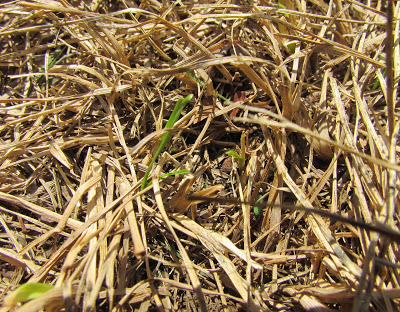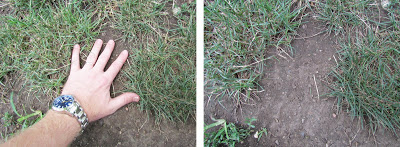Many areas in Indiana have received recent rains to their lawns. Some lawns have greened-up and others are still brown leaving many wondering whether their lawns are dead or alive. Below are some images that illustrate the process of determining whether or not your lawn is dead or alive.
Step 1. In an area of suspected dead turf (brown areas), pull at the brown (dead) leaf blades.
Step 2. After pulling up some of the dead leaf blades, examine the ground closely and look for signs of new growth. All new turf growth comes from the crown of the plant (turf) and these crowns are located at or near the soil surface.
Step 3. If you find new turf emerging in these dead areas then that is good news that your turf will recover from drought and heat injury. If not, wait a few more weeks and reexamine these areas.
 Step 4. If no new growth is occurring in areas you might need to reseed these spots. For lawns with bunch-type grasses such as tall fescue and perennial ryegrass, reseed dead spots larger than 3 inches in diameter. For Kentucky bluegrass lawns, reseed dead spots larger than 6 inches in diameter (about the size of your hand, or at least mine). Since Kentucky bluegrass has rhizomes (underground stems) it has a greater recuperative capacity than bunch-type grasses. The photo below shows a bare area between clumps of perennial ryegrass.
Step 4. If no new growth is occurring in areas you might need to reseed these spots. For lawns with bunch-type grasses such as tall fescue and perennial ryegrass, reseed dead spots larger than 3 inches in diameter. For Kentucky bluegrass lawns, reseed dead spots larger than 6 inches in diameter (about the size of your hand, or at least mine). Since Kentucky bluegrass has rhizomes (underground stems) it has a greater recuperative capacity than bunch-type grasses. The photo below shows a bare area between clumps of perennial ryegrass.
